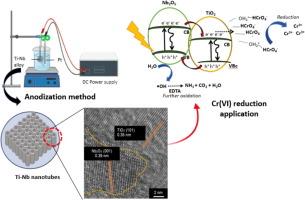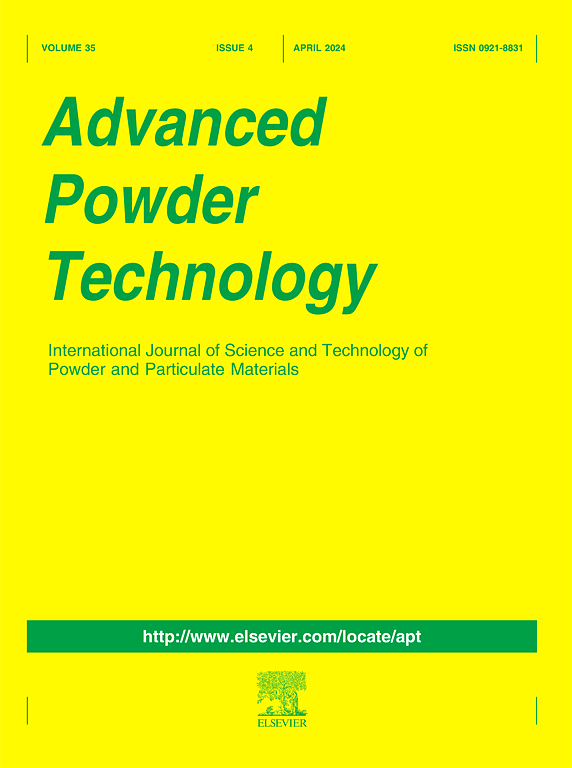Anodic growth of nanotubular TiO2/Nb2O5 on Ti-Nb alloys for photocatalytic Cr(VI) removal
IF 4.2
2区 工程技术
Q2 ENGINEERING, CHEMICAL
引用次数: 0
Abstract
Hexavalent chromium [Cr(VI)] is a highly toxic and persistent environmental pollutant, posing serious risks to human health and ecosystems. Its photocatalytic reduction to the more benign trivalent chromium [Cr(III)] remains a critical challenge in environmental remediation. This study investigates the formation of nanotubular oxide layers on titanium-niobium (Ti-Nb) alloy pellets via anodization to form a semiconductor photocatalyst for enhanced Cr(VI) reduction. The alloy pellets were prepared using powder metallurgy with Nb contents of 20, 40, and 60 wt% added to Ti powders. After sintering, X-ray diffraction confirmed that Ti-20Nb, Ti-40Nb, and Ti-60Nb primarily contained α-Ti with minor β-Ti phases, with β-Ti increasing as Nb content increased. Anodization of these alloy pellets in a fluoride electrolyte produced well-ordered nanotubular oxide layers with longest nanotubes observed on Ti-40Nb. The anodic oxide was initially amorphous but transformed into a mixed TiO2/Nb2O5 structure upon annealing. While Ti-20Nb and Ti-40Nb were dominated by anatase TiO2, Ti-60Nb exhibited rather amorphous oxide with HRTEM can see nanocrystallites of TiO2 and Nb2O5. Photocatalysis experiments demonstrated that Ti-60Nb showed the best Cr(VI) reduction performance, achieving complete reduction under UV light within 120 min and 90 % reduction under solar irradiation, outperforming pure Ti. The enhanced performance is attributed to the formation of TiO2/Nb2O5 junctions, which improve charge carrier dynamics suppressing electron-hole recombination.

纳米管TiO2/Nb2O5在Ti-Nb合金上阳极生长光催化脱除Cr(VI
六价铬[Cr(VI)]是一种剧毒的持久性环境污染物,对人类健康和生态系统构成严重威胁。它的光催化还原成更良性的三价铬[Cr(III)]仍然是环境修复的关键挑战。本研究通过阳极氧化在钛铌(Ti-Nb)合金球团上形成纳米管状氧化物层,形成增强Cr(VI)还原的半导体光催化剂。采用粉末冶金法制备了铌含量分别为20%、40%和60%的合金球团。烧结后x射线衍射证实,Ti-20Nb、Ti-40Nb和Ti-60Nb主要含有α-Ti相,少量含有β-Ti相,β-Ti随Nb含量的增加而增加。这些合金球团在氟化电解质中阳极氧化产生有序的纳米管氧化物层,在Ti-40Nb上观察到最长的纳米管。阳极氧化物最初呈无定形,退火后转变为TiO2/Nb2O5混合结构。Ti-20Nb和Ti-40Nb以锐钛矿型TiO2为主,Ti-60Nb表现为非晶态氧化物,HRTEM可观察到TiO2和Nb2O5的纳米晶。光催化实验表明,Ti- 60nb表现出最好的Cr(VI)还原性能,在紫外光下120 min内完全还原,在太阳照射下还原90%,优于纯Ti。TiO2/Nb2O5结的形成改善了载流子动力学,抑制了电子-空穴复合。
本文章由计算机程序翻译,如有差异,请以英文原文为准。
求助全文
约1分钟内获得全文
求助全文
来源期刊

Advanced Powder Technology
工程技术-工程:化工
CiteScore
9.50
自引率
7.70%
发文量
424
审稿时长
55 days
期刊介绍:
The aim of Advanced Powder Technology is to meet the demand for an international journal that integrates all aspects of science and technology research on powder and particulate materials. The journal fulfills this purpose by publishing original research papers, rapid communications, reviews, and translated articles by prominent researchers worldwide.
The editorial work of Advanced Powder Technology, which was founded as the International Journal of the Society of Powder Technology, Japan, is now shared by distinguished board members, who operate in a unique framework designed to respond to the increasing global demand for articles on not only powder and particles, but also on various materials produced from them.
Advanced Powder Technology covers various areas, but a discussion of powder and particles is required in articles. Topics include: Production of powder and particulate materials in gases and liquids(nanoparticles, fine ceramics, pharmaceuticals, novel functional materials, etc.); Aerosol and colloidal processing; Powder and particle characterization; Dynamics and phenomena; Calculation and simulation (CFD, DEM, Monte Carlo method, population balance, etc.); Measurement and control of powder processes; Particle modification; Comminution; Powder handling and operations (storage, transport, granulation, separation, fluidization, etc.)
 求助内容:
求助内容: 应助结果提醒方式:
应助结果提醒方式:


